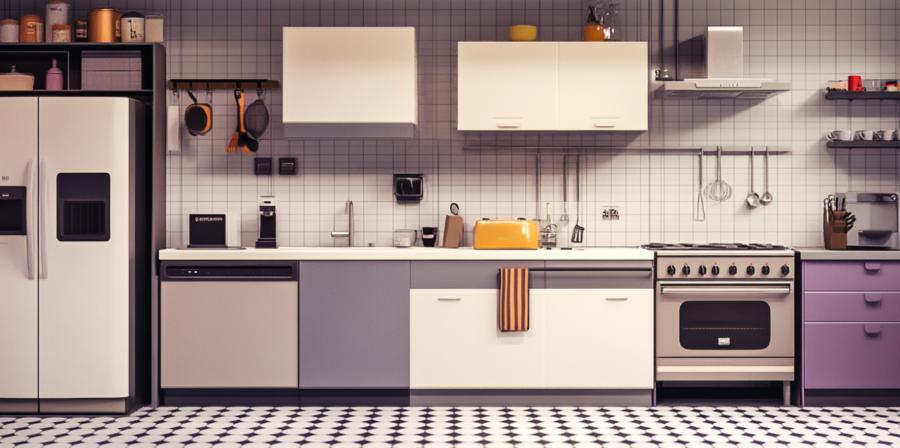Reimagining the Work Triangle
Most kitchens cling to the classic work triangle as if it were an ancient decree. In truly tight quarters, though, placing the sink, stove, and fridge in a neat geometric relationship isn’t always realistic. Instead, imagine mini-clusters that function as small command posts. One corner becomes your chopping hub; another transforms into the beverage station; the third turns into a compact cooking powerhouse. Suddenly, your kitchen behaves like a well-run miniature city—minus the traffic, unless your cat insists on supervising.These micro-zones simplify your movements. Less wandering, more doing. And when every inch counts, fewer steps can feel like newfound luxury.
Storage Geometry You Didn’t Know You Needed
Small kitchens love to expose the limits of traditional storage. That’s why approaching your cabinetry as geometric opportunity rather than mere boxes can change everything. Angled pullouts, diagonal corner drawers, and tiered shelves let you tuck away items with surprising elegance. A whisk never needs to tango with the blender blades again.For spaces where drawers collide or doors bump into appliances, consider mechanisms that glide, pivot, or fold. These aren’t just gimmicks; they’re spatial strategies that prevent the daily “why won’t this open?” ritual many small-kitchen owners know too well.
Hidden Prep Areas for Secret Culinary Deeds
If your countertop looks full after you put down a single cutting board, you’re not alone. Hidden prep surfaces are the undercover agents of compact-kitchen upgrades. Think sliding boards nestled above drawers, fold-down stations attached to the wall, or a modest butcher-block insert that lifts out like a magician’s reveal.These additions deliver prep space only when needed, then vanish without complaint. And unlike a houseguest who overstays, hidden stations slip away quietly. Suddenly you have room to chop herbs without performing acrobatics over the sink.
Appliance Clustering for Controlled Chaos
Here’s where things get strategic. Instead of scattering appliances like confetti across the room, clustering them by function creates pockets of purpose. Your coffee maker, grinder, and mugs form a morning zone that minimizes bleary-eyed wandering. Meanwhile, the toaster, small oven, and bread storage become a carbohydrate command center.- Group heat-generating appliances to streamline ventilation solutions.
- Keep food-prep gadgets near concealed counter space for quicker action.
- Place occasional-use appliances in upper or rear storage to reduce clutter.
Lighting That Works Harder Than It Looks
Compact kitchens often suffer from shadows that appear precisely where you need clarity the most. Rather than relying on a single overhead fixture that tries—and fails—to illuminate every corner, layered lighting steps in as the unsung hero. Under-cabinet strips brighten prep zones without fanfare, while focused pendants can give your primary working cluster the spotlight it deserves.A well-lit kitchen doesn’t just look larger; it behaves larger. Shadows retreat, surfaces feel more available, and you stop mistaking your paprika for cayenne—unless you enjoy gambling with your taste buds.
Material Choices That Stretch Perception
Some surfaces seem engineered to magnify tight spaces, while others shrink them instantly. Softer sheens, modest color shifts, and materials that bounce rather than absorb light create the impression of breathing room without altering the blueprint. Think modestly glossy tiles that brighten without blinding, or countertops with subtle patterning that distract in just the right amount.Even flooring can play a quiet role. Larger planks reduce visual interruption, gently guiding the eye along one continuous plane. And for anyone who’s spent time navigating a cramped kitchen, uninterrupted flooring feels almost like a small kindness from the renovation gods.
Behavioral Zoning for Realistic Living
Task zones aren’t just physical—they’re behavioral. The area where you set down your mail each evening? That’s a zone. The spot where you absentmindedly keep the olive oil because you once cooked there and never questioned it again? Another zone. A renovation becomes dramatically more effective when it acknowledges these habits instead of fighting them.Sometimes this means adjusting a layout to support the path you naturally take when cooking. Other times, it requires a micro-intervention, such as placing frequently used items within arm’s reach instead of buried in drawers that require archaeological excavation.
- Observe your patterns for a week before committing to layout changes.
- Prioritize zones where friction tends to happen—like prep and storage adjacencies.
- Build systems that support how you cook, not how you imagine you cook.
A Tiny Space Walks Tall
A small kitchen that embraces task zoning behaves with a confidence far above its square footage. It stops apologizing for its size and starts showcasing its efficiency. You move with more intention, items appear where you expect them, and surfaces seem to cooperate rather than resist.What once felt like a cramped chamber becomes a purposeful environment built around how you think, cook, and live. And the moment you find yourself gliding from prep zone to appliance cluster without bumping an elbow or muttering creative vocabulary, you’ll realize your compact kitchen hasn’t just been renovated—it’s been elevated.
Article kindly provided by kitchenrenovationlondon.co.uk

